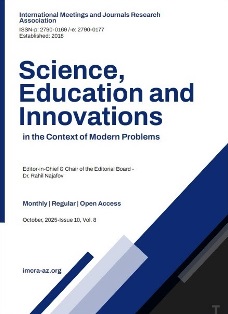-
PEER REVIEW PROCESS
🧾 Double-Blind Peer Review Policy
At Science, Education and Innovations in the Context of Modern Problems, we are committed to upholding rigorous academic standards through a double-blind peer review process. This ensures the objectivity, integrity, and academic merit of the published work.
1. Overview of the Double-Blind Model
In a double-blind review, both the identity of the authors and the reviewers are concealed throughout the review process. This method minimizes bias and promotes fair and unbiased evaluation of the manuscript based solely on its academic and scientific content.
-
Authors do not know the identity of reviewers.
-
Reviewers do not know the identity of the authors.
2. Stages of the Peer Review Process
Step 1: Initial Editorial Assessment
-
Upon submission, the manuscript undergoes a preliminary evaluation by the Editor-in-Chief or Managing Editor to determine its suitability for the journal's scope and standards.
-
Submissions that do not meet the basic quality, relevance, or formatting requirements may be desk-rejected at this stage.
Step 2: Plagiarism and Ethical Screening
-
All manuscripts are checked using plagiarism detection software (e.g., iThenticate or similar tools).
-
Manuscripts with a similarity index exceeding 25% (excluding references, standard phrases, and methodology) are returned to the author for revision or rejection.
-
Ethical issues, such as conflicts of interest or unethical research practices, are screened at this stage.
Step 3: Reviewer Assignment
-
Each manuscript is assigned to two independent expert reviewers with relevant subject expertise.
-
Reviewers are selected from our editorial database and external networks, ensuring no conflicts of interest exist.
-
A third reviewer may be invited if the first two evaluations are significantly contradictory.
Step 4: Review Process
-
Reviewers are given 2–4 weeks to complete their evaluation.
-
Reviews are conducted using a standard evaluation form, focusing on:
-
Originality and contribution to the field
-
Scientific accuracy and methodology
-
Clarity, coherence, and structure
-
Adequacy of references and citations
-
Ethical compliance
-
Step 5: Editorial Decision
Based on the reviewers’ reports, the editorial team makes one of the following decisions:
-
Accept without revision
-
Minor revision
-
Major revision
-
Reject
Authors are notified of the decision along with anonymized reviewer comments. Where revisions are requested, authors are expected to submit a revised manuscript and a detailed response letter addressing each reviewer comment.
Step 6: Revised Submission and Re-Evaluation
-
Revised manuscripts are re-evaluated by the original reviewers (where possible).
-
Final decisions are made by the Editor-in-Chief based on the revised version and reviewer feedback.
3. Author Guidelines for Double-Blind Review
To maintain the integrity of the double-blind review, authors must ensure the following when submitting a manuscript:
-
Do not include names, affiliations, or any identifying information in the manuscript file.
-
Avoid self-identifying citations (e.g., “as we previously showed in our study [1]”).
-
Submit a separate title page with full author details (name, ORCID, institution, email) which will not be shared with reviewers.
4. Reviewer Guidelines and Ethics
-
Reviewers must provide objective, constructive, and confidential feedback.
-
Any conflicts of interest must be declared before accepting a review assignment.
-
Reviewers are expected to evaluate manuscripts within the agreed timeline and uphold confidentiality of the review process.
5. Conflicts of Interest and Appeals
-
Authors and reviewers are required to disclose any potential conflicts of interest.
-
Authors have the right to appeal editorial decisions by providing a clear and reasoned justification, which will be re-evaluated by a different editor or reviewer when appropriate.
6. Confidentiality
All submitted manuscripts, reviewer identities, and correspondence are treated as confidential information throughout and after the review process.
📩 For any questions about the review process, please contact:
📧 editor@imcra-az.org -


















